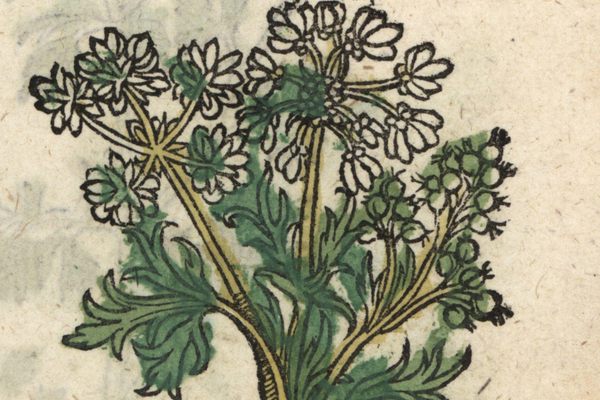How Poisonous Fruit Pits Became Irresistible to Humans
These plants make cyanide.
THIS ARTICLE IS ADAPTED FROM THE SEPTEMBER 23, 2023, EDITION OF GASTRO OBSCURA’S FAVORITE THINGS NEWSLETTER. YOU CAN SIGN UP HERE.
I drank iced, frothy tejate for the first time last summer, at a market in Oaxaca, Mexico. Refreshing and lightly sweet, it reminded me of a chocolate protein shake. Tejate does contain cacao nibs, along with dry corn and pixtle, the seed kernels of the mamey sapote fruit. These are toasted and ground together with the fragrant flowers of a different plant called flor de cacao, then mixed with water to produce the beverage, which has ancient pre-Colombian roots.
Inside each mamey, a single large, dark pit nestles against the creamy orange flesh. When I found mamey at my local grocery store in NYC a few weeks ago, I saved the pits, hoping to make my own tejate. I would have to omit the flor de cacao, but I could acquire the other ingredients. The procedure seemed fairly straightforward … or so I imagined.
I smashed open a mamey pit with the flat of a knife and peeled off the dark outer shell, revealing a white kernel underneath. Immediately, a deliciously sweet smell rose into the air. It reminded me of cherries and almonds, or almond extract. I started to get excited for the flavor of my tejate; but then I remembered how I recently used almond extract to recreate a 19th-century recipe that originally called for bitter almonds.

Though historically prized for sweets and liqueurs, bitter almonds are banned for commercial sale in the US because they are, in addition to being very flavorful, very poisonous. As few as five bitter almonds could be lethal to a child; 50 could kill an adult. I realized that the mamey pit I was so keen on eating probably smelled good for the same reason bitter almonds do: cyanide.
Technically, “the hydrogen cyanide is the toxic compound, but you cannot detect it with your nose,” says Dr. Raquel Sánchez-Pérez, a senior biochemist at the CEBAS-CSIC agricultural research center in Spain. “The aroma or the flavor comes from benzaldehyde.”
When a bitter almond is chewed or crushed, a chemical called amygdalin reacts with enzymes and breaks down, releasing both cyanide and benzaldehyde. Sweet almonds, the ones we eat, are much less fragrant because they contain only trace amounts of amygdalin: 0.05% or less, compared to three to five percent in bitter almonds.
Amygdalin is named after the Ancient Greek word for almond, as is the almond-shaped amygdala in the human brain. Inside an almond’s cells, amygdalin and the enzymes it reacts with are sealed in separate compartments. They come together and react, Sánchez-Pérez explains, “when the tissue is broken by a herbivore—for example, a bird that is trying to eat the almond seed.” It’s a mechanism that evolved to protect the plant. “They cannot move, so they have to defend themselves,” says Sánchez-Pérez.
She points out that some of the same enzymes “are present in our bacteria that we have in our mouths,” increasing the reaction. The scent and flavor of benzaldehyde is also defensive, as it can warn herbivores to stop eating the almond (or in my case, the mamey pit). Sánchez-Pérez notes that some animals, such as crows and wild pigs, know not to eat bitter almonds by their smell alone.
Cyanogens—compounds that generate cyanide when they break down—are found in thousands of plant species, and mamey is one of them. Besides almond, probably the most significant cyanogenic food plant is cassava, also known as manioc or yuca (not to be confused with the desert plant yucca). Although bitter cassava is only edible after lengthy processing to remove its toxins, its starchy roots produce both tapioca and a staple food source for over half a billion people in tropical regions. Like almonds, there are sweet and bitter kinds of cassava, and you are unlikely to encounter the bitter kind in the United States.

In the genus Prunus, which includes almonds as well as stone fruits like peaches, cherries, and apricots, cyanogenic amygdalin is found in the inner kernels of the pits. But some seeds, like sweet almonds, pose much less danger than others. If these poisonous reactions are a defense designed to stop the plant’s seeds from getting eaten, why don’t all almonds have them?
“The original almonds were bitter,” says Sánchez-Pérez. She describes the discovery of prehistoric almonds in 19,000-year-old food stores in Israel, the earliest evidence of human almond consumption. Almonds have been found in Egyptian tombs and are mentioned in the Bible, in Greek mythology, and in ancient Chinese medical guides. In ancient times, people used both bitter and sweet almonds in cuisine, though bitter almonds had to be used sparingly. Cooks also used various methods to remove at least some of the toxins. Baking, boiling and microwaving can all reduce the levels of cyanide in bitter almonds.
A study that Sánchez-Pérez co-authored, published in Science in 2019, isolated a single gene responsible for the trait of bitterness in almonds. The study also revealed that it was a random genetic mutation that originally produced sweet almond trees with very low amygdalin levels. Though exactly when this occurred is unknown, the mutation allowed people to domesticate almonds for the first time, since the seeds could now be eaten in larger quantities without processing.
A Roman agriculture guide from the fourth century claimed that farmers could force a bitter almond tree to produce sweet almonds by piercing the roots with a pinewood stake. The stress of damage to the roots may have slowed the tree’s amygdalin production, giving the impression that true sweet almonds had been produced. In reality, “there are no almond trees that produce some sweet and some bitter,” says Sánchez-Pérez.

Since sweet almond trees are far more commercially desirable today, and a sweet almond tree that carries the gene for bitterness can still produce bitter offspring, isolating that gene is key to more efficient almond production. “The almond tree doesn’t produce seeds until the first three to four years,” says Sánchez-Pérez. “So we are saving a lot of time and effort for the breeders, so they bring only the almonds to the field that they are very interested in later on.”
Today, the need for bitter almonds has largely been filled by commercial almond extract, but they are still cultivated for traditional recipes and as ornamental trees. The kernels from other Prunus species also have culinary applications, especially after boiling or baking to destroy the hydrogen cyanide.
In Europe, apricot kernels are included with the fruit in some recipes for preserves, and are sometimes erroneously called “bitter almonds” because of their similar flavor and smell. Peach and apricot kernels are ground with sugar into a paste called persipan, which is sold as a cheaper substitute for marzipan. Apricot kernels are also found in Chinese medicine and in some Chinese recipes, and the Middle Eastern spice mahlab, commonly used in pastries and cakes, is made from the kernels of a type of cherry.
It turns out that making edible pixtle from mamey seeds requires significant processing. Traditionally, the inner kernels of mamey pits are boiled and broken into small pieces, then are dried, roasted, and strung like beads before being sold as pixtle. Since I didn’t know the nuances of this process, or whether I was using a different variety of mamey than what Oaxacans use, I opted to play it safe and halt my tejate experiment. But I did save the mamey pits in the freezer, in case I ever learn how to prepare them properly. I’m glad that the alluring scent of benzaldehyde warned me to tread carefully.
Gastro Obscura covers the world’s most wondrous food and drink.
Sign up for our email, delivered twice a week.

























Follow us on Twitter to get the latest on the world's hidden wonders.
Like us on Facebook to get the latest on the world's hidden wonders.
Follow us on Twitter Like us on Facebook